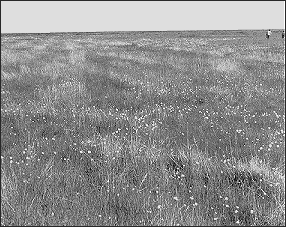
 |
| Plate 61.--Classification: SYSTEM Palustrine, CLASS Emergent Wetland, SUBCLASS Persistent, DOMINANCE TYPE Eleocharis palustris, WATER REGIME Seasonally Flooded, WATER CHEMISTRY Polysaline, SOIL Mineral. Subordinate plants include water smartweed (Polygonum amphibium), slough sedge (Carex atherodes), and foxtail (Alopecurus aequalis). (Stutsman County, North Dakota; August 1962; Photo by R. E. Stewart) |
 |
| Plate 62.--Classification: SYSTEM Palustrine, CLASS Emergent Wetland, SUBCLASS Persistent, WATER REGIME Seasonally Flooded, WATER CHEMISTRY Mixosaline, SOIL Mineral. The principal plants are sedges (Carex spp.), bulrushes (Scirpus spp.), rushes (Juncus spp.), and foxtail (Alopecurus aequalis). This wetland is typical of irrigated hay in the West. Water may be diverted from rivers or may come from artesian wells as in this photo. (Saguache County, Colorado; Photo by R. M. Hopper) |
 |
| Plate 63.--Classification: SYSTEM Palustrine, CLASS Emergent Wetland, SUBCLASS Persistent, DOMINANCE TYPE Carex rariflora--Eriophorum russeolum, WATER REGIME Seasonally Flooded, WATER CHEMISTRY Fresh. Subordinate plants include marsh cinquefoil (Potentilla palustris), bluejoint (Calamagrostis canadensis), Alaska bog willow (Salix fuscescens), crowberry (Empetrum nigrum), dwarf birch (Betula nana), and peat moss (Sphagnum sp.). This type of patterned wetland is commonly referred to as "string bog" or "strangmoor." Seasonally flooded troughs alternate with elongated bog-like ridges or "strings." Strings here rise only 30-45 cm (12-18 in) above the troughs. (Manokinak River area, Yukon-Kuskokwim Delta, Alaska; July 1985; Photo by F. C. Golet) |
 |
| Plate 64.--Classification: SYSTEM Palustrine, CLASS Emergent Wetland, SUBCLASS Persistent, DOMINANCE TYPE Colocasia esculenta, WATER REGIME Seasonally Flooded, WATER CHEMISTRY Fresh, SOIL Mineral, SPECIAL MODIFIER Farmed. This photograph illustrates a Hawaiian taro field. (Kauai County, Hawaii; September 1972; Photo by E. Krider) |